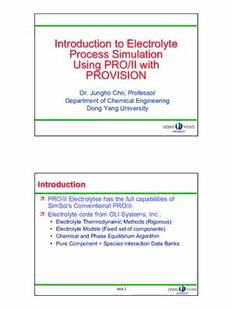Table Of ContentIInnttrroodduuccttiioonn ttoo EElleeccttrroollyyttee
PPrroocceessss SSiimmuullaattiioonn
UUssiinngg PPRROO//IIII wwiitthh
PPRROOVVIISSIIOONN
Dr. Jungho Cho, Professor
Department of Chemical Engineering
Dong Yang University
IInnttrroodduuccttiioonn
(cid:202) PRO/II Electrolytes has the full capabilities of
SimSci's Conventional PRO/II.
(cid:202) Electrolyte code from OLI Systems, Inc.,
(cid:121) Electrolyte Thermodynamic Methods (Rigorous)
(cid:121) Electrolyte Models (Fixed set of components)
(cid:121) Chemical and Phase Equilibrium Algorithm
(cid:121) Pure Component + Species Interaction Data Banks
Slide 2
IInnttrroodduuccttiioonn
(cid:202) SIMSCI’s ELDIST algorithm for modeling
distillation columns with electrolytes,
(cid:202) ELECTROLYTE UTILITY PACKAGE
(cid:121) User-added Electrolyte Model Generation Program
(cid:121) Data Bank Management Program
Slide 3
IImmpplleemmeennttaattiioonn
SimSci SimSci/OLI OLI Systems SimSci/OLI
PRO/II Interface Electrolytes Utility Package
Set Up
P Models
R
O
II Built-In
OLILIB
w Thermo Model
P Equations Data Bank
R Perform (DBSFILE)
Models
O Flash
V (cid:202)Equilibri Model
I um Generation
S Set Up (cid:202)Solver
I ELDIST
O
OLI
N
Component
Data Banks
Slide 4
UUnniitt OOppeeaattiioonnss
(cid:202) Unit Operation Modules built in PRO/II
(cid:121) Flash
(cid:121) Calculator
(cid:121) Pump
(cid:121) Controller
(cid:121) Valve, Mixer, Splitter
(cid:121) Optimizer
(cid:121) Pipe
(cid:121) ELDIST Column
(cid:121) HEX, LNG HEX
(cid:121) Conversion Reactor
(cid:121) Stream Calculator
(cid:121) Equilibrium Reactor
(cid:121) HCURVE
(cid:121) Batch Reactor
Slide 5
TThheerrmmooddyynnaammiicc MMooddeellss (( II ))
(cid:202) Pregenerated models for 40 systems:
(cid:121) Amine systems
(cid:121) Caustic systems
(cid:121) Acid systems
(cid:121) Benfield systems
(cid:121) Mixed salt systems
(cid:121) Scrubber systems
(cid:121) Sour water systems
(cid:121) LLE and Hydrate systems
Slide 6
TThheerrmmooddyynnaammiicc MMooddeellss (( IIII ))
(cid:202) User added model can be generated using
Electrolyte Utility Package(EUP):
(cid:121) Maximum of 60 built-in models allowed
(cid:121) Maximum of 50 model components allowed, but 30
component maximum is recommended.
Slide 7
AApppplliiccaattiioonn RRaannggee
(cid:202) Aqueous Elelctrolyte
(cid:121) Temperature: 0 ~ 200 C
(cid:121) Pressure: 0 ~ 200 atm
(cid:121) Dissolved Gases: 0 ~ 30 mole%
(cid:121) Ionic Solutes: 0 ~ 30 ionic strength
(cid:202) Amine System
(cid:121) Pressure: 0 ~ 30 atm
(cid:202) LLE System
(cid:121) Organic Solutes: Max wt% = 10
Slide 8
PPRROO//IIII EElleeccttrroollyyttee && CCoonnvveennttiioonnaall PPRROOIIII
(cid:202) PRO/II Electrolyte Module takes the followings into
account:
(cid:121) Chemical and Phase Equilibria
(cid:121) Charge Balance
(cid:121) Material Balance
(cid:202) All Thermodynamic Method in Conventional
PRO/II tank into account only Phase Equilibria
except:
(cid:121) SOUR
(cid:121) GPSWATER
(cid:121) AMINE
Slide 9
CCoommppoonneenntt RReeccoonnssttiittuuttiioonn
(cid:202) Phase and chemical equilibrium are solved for
unknown concentrations of the true species (ionic,
neutral) in the aqueous phase.
(cid:202) A reconstitution procedure is used to calculate
apparent concentrations of the model’s neutral
components that are consistent with the true
species concentrations.
Slide 10
CCoommppoonneenntt RReeccoonnssttiittuuttiioonn
(cid:202) Example:
(cid:121) Models components: H2O, NAOH, HCL, NACL
(cid:121) Feed components: 50mol H2O + 1mol NAOH + 1mol
HCL
(cid:121) Product as True Chemical Species:
51mol H2O+1mol NA+1+1mol CL-1+10-7mol OH-1+10-7mol H+1
(cid:202) Product as Reconsitituted Components: 51mol
H2O + 1mol NACL
(cid:202) Reconstitution is automatic.
(cid:202) Output gives true and reconstituted values.
Slide 11
SSiimmuullaattiioonn SStteeppss:: PPrreeddeeffiinneedd MMooddeess
1. Description of the simulation
2. Input Unit of Measurement
3. Select Electrolyte Thermodynamic
Slide 12
SSiimmuullaattiioonn SStteeppss:: PPrreeddeeffiinneedd MMooddeess
4. Component Databank: OLILIB and SIMSCI Bank
5. Build PFD with Unit Operations and Streams
6. Run
7. Generate Output
Slide 13
PPrroobblleemm ##11:: HHCCLL && HH22OO SSoolluuttiioonn
(cid:202) Run a simple Flash model for H2O-HCL system
using:
(cid:121) NRTL Method
(cid:121) HCL Electrolyte Method
(cid:202) And then compare the results.
Slide 14
PPrroobblleemm ##11:: HHCCLL && HH22OO SSoolluuttiioonn
Stream Name HCL
Stream Description VAPOR
Phase Vapor
Temperature 20.000 C
Pressure 1.033 KG/CM2
Flowrate 50.000 KG-MOL/HR
Composition
H2O 0.000 FLASH
HCL 1.000
DP=0.0, Duty=0.0
Stream Name H2O
Stream Description
Phase Liquid
Temperature 20.000 C
Pressure 1.033 KG/CM2
Flowrate 100.000 KG-MOL/HR
Composition
H2O 1.000 AQUEOUS
HCL 0.000
Slide 15
PPrroobblleemm ##11:: HHCCLL && HH22OO SSoolluuttiioonn
VLE LIQUID INTERACTION PARAMETERS FOR H2O-HCL PAIR
NRTL BINARY COEFFICIENTS
I J A(I,J) B(I,J) C(I,J) ALPHAC UNITS FROM
A(J,I) B(J,I) C(J,I) ALPHAT
------ -------- ---------- ----------- ------- -------------
1 2 0.000000 2222.9199 0.00 0.2007 DEG K SIMSCI VLEBANK
0.000000 -2037.3400 0.00 0.0000
X-Y Plot for HCL and H2O
1.0
x = y
Equilibrium curve
Mole Fraction HCL00..68
mposition, 0.4
Vapor Co0.2
0
0 0.2 0.4 0.6 0.8 1.0
Liquid Composition, Mole Fraction HCL
Slide 16
PPrroobblleemm ##22:: NNaa22CCOO33 SSoolluubbiilliittyy iinn WWaatteerr
(cid:202) Employ a Flash Solid model to determine the
solubility of Na2CO3 in water.
FWS1 TEMP = 25 C
PRES = 1.0332 KG/CM2
CA1
LIQUID
Stream Name FEED
Fluid Rates KG-MOL/HR
H2O 55.51
NA2CO3 5.00
Temperature 25.00 C
Pressure 1.0197 KG/CM2
SOLID
ELECTROLYTE SYSTEM = LLE AND HYDRATE
ELECTROLYTE MODEL = TWL1
Slide 17
PPrroobblleemm ##22:: NNaa22CCOO33 SSoolluubbiilliittyy iinn WWaatteerr
(cid:202) Employ Case Study option for the followings:
- Temperature from 5 C to 100 C with step size = 5 C
5.0
Molality
4.0
3.0
Molality
2.0
1.0
0
0 20.0 40.0 60.0 80.0 100.0
TEMP, C
Slide 18
PPrroobblleemm ##33:: SSooddiiuumm CChhlloorriiddee SSoolluuttiioonn
VAPOR
55.1 kg-mol/sec HO
2
6.5 kg-mol/sec NaCl
0.1 kg-mol/sec CO Isothermal
2
Flash
25 C
FEED 1 bar LIQUID
Solids
Separator
LIQUID &
SOLID
SOLID
Slide 19
PPrroobblleemm ##33:: SSooddiiuumm CChhlloorriiddee SSoolluuttiioonn
(cid:202) Part 1:
(cid:121) Is the CO2 absorbed in the solution and to what
extent?
(cid:121) Is the solution saturated with NaCl?
(cid:121) Is there an excess of salt, and does it form a solid
phase?
(cid:121) What is the pH of the solution?
(cid:202) Part 2:
(cid:121) How does increasing the temperature of the flash
change the pH and NaCl concentration of the outlet
streams?
Slide 20

